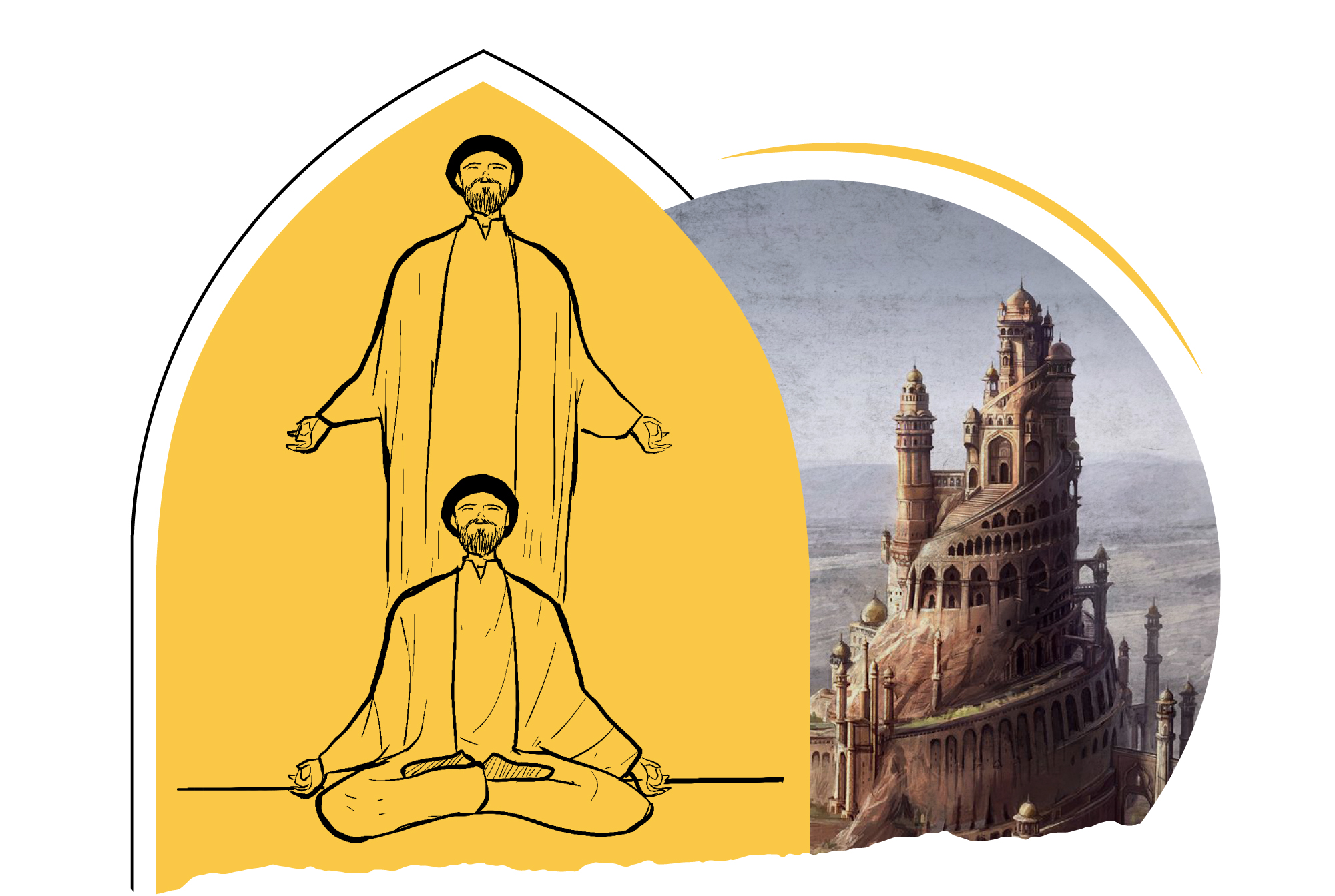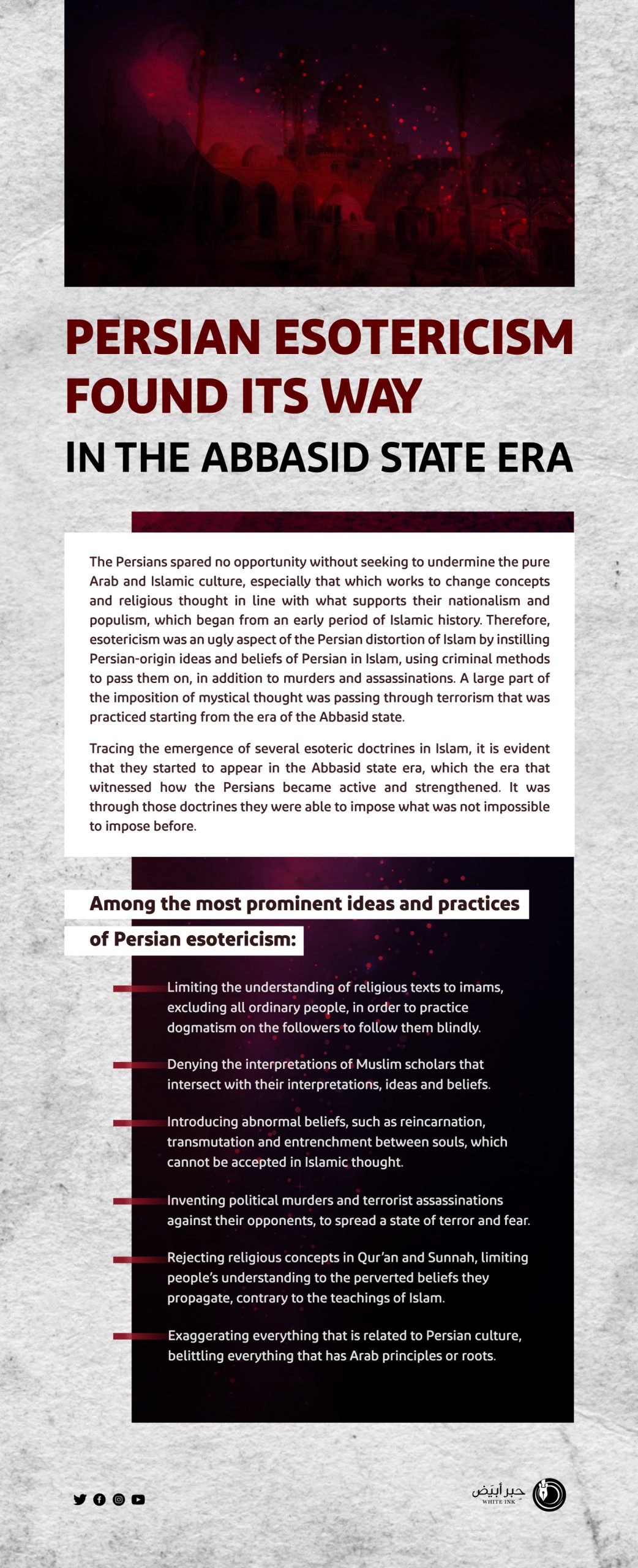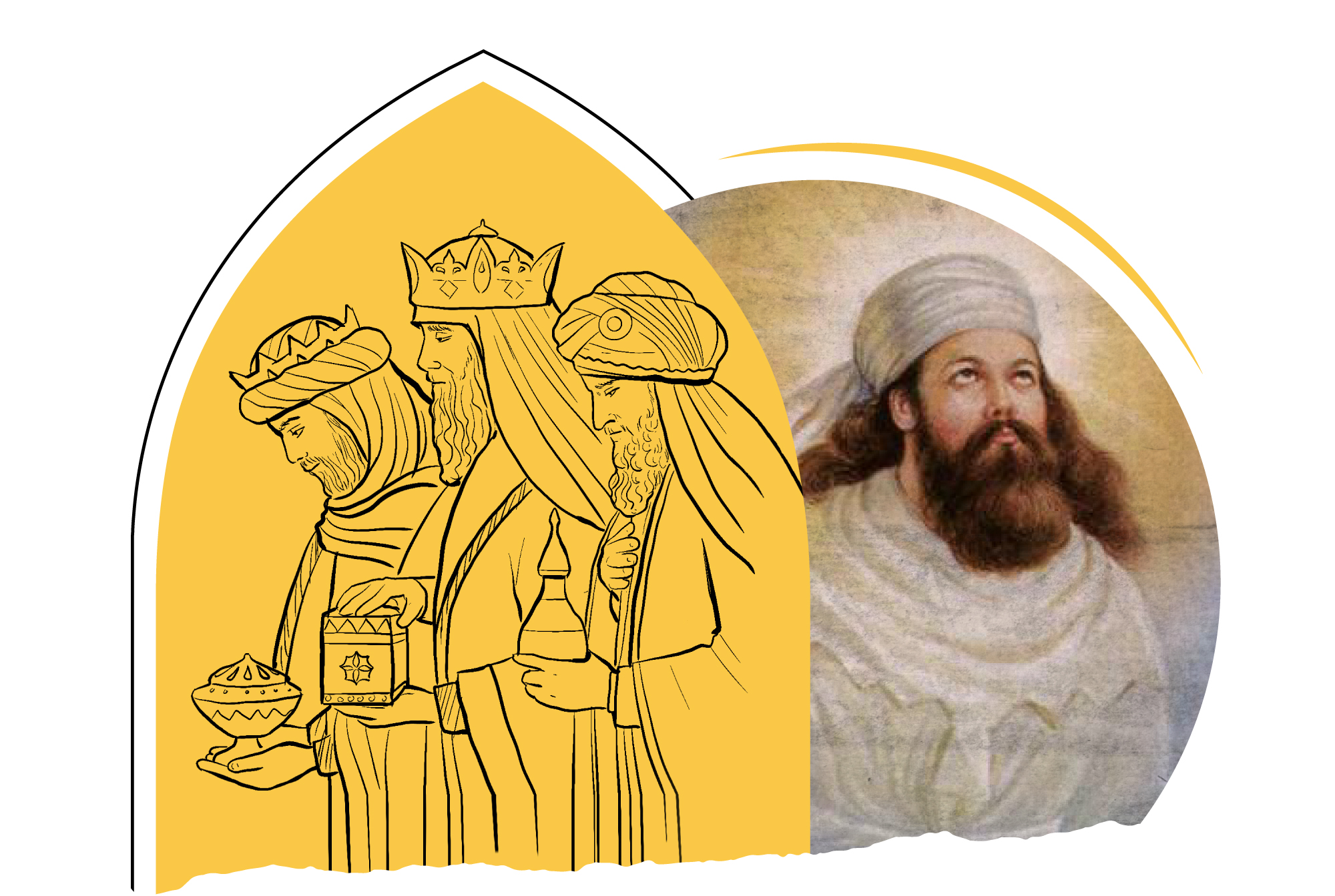
Anthology of Ancient Religions Philosophies
Persian Origin of Deviant Esoteric Movements in Islam
Esoteric movements are among the most dangerous destructive movements in Islamic history, claiming affiliation therewith, while their hidden true objective was to distract Islamic religion from its genuine purposes, questioning it and its importance. What renders these esoteric movements and their malicious intentions even more dangerous is that most of them have disguised behind an emotional religious slogan.
Scholars, almost unanimously, are of the opinion that esotericism was launched by a punch of radicals, which emerged and spread in Islamic world, based on the main call that religious texts have external concepts that the general public is aware of, as well as intrinsic concepts that can only be perceived by the elite whom Allah singled out for matters of faith. Some even went as far as declaring their imams’ divinity. Such radicals were called the esoteric because of their claim that Qur’an and the stories therein have intrinsic meanings much deeper than their extrinsic meanings.
Those movements created the esoteric approach in interpreting Sharia in a manner that ultimately led to Sharia abrogation with a view to popularize their esoteric thought, derived mainly from a mixture of ancient Persian religions and Judaism, consulting Greek philosophy when required. Esoteric movements also denied the various interpretations put forth by the esteemed scholars of Islam. They believed that only the imam is empowered with the right to interpret religious texts. Most esoteric movements believe in the principle of “reincarnation”, i.e., transmigration of souls, whether between man and man or even between man and animal, as supported by their teams.
Among the odd, anomalous teachings was what Maymun al-Qaddah advocated, to whom the Maimuniya is attributed, which is closely related to “Khattabiyyah”, was claiming the prohibition of adopting the extrinsic meanings of Qur’an and Sunnah and rejecting the concept of resurrection in the afterlife.
All scholars responded by rejecting that misguiding and misleading thought of the esoteric movements. Rather, they basically refused to attribute them to the “eccentric / Al-Batin” concept because “Al-Batin” is one of the names of Allah, which linguistically means: the hidden from creatures’ sight and delusions, so He cannot be seen by sight, nor perceived by illusion.
Senior scholars have authored several works in response to the misguided and misleading thought of the esoteric movements. Researchers have unanimously agreed on the role played by Persian extremists in creating the esoteric thought and movement. Abd al-Wahhāb ʻAzzām, one of the pioneers of Persian studies in the Arab world, gives an important political and ethnic explanation behind some Persians creating such movements. He is of the opinion that Persian ultranationalists, despite their conversion to Islam, remained on their hatred of the Arabs and Islam, as was evident in the era of Umayyad state. Then their hopes of controlling the nation were revived with the establishment of the Abbasid state, thanks to the “Persian” Abu Muslim al-Khurasani, whose murder caused a great shock to the Persians, to the extent that they did not believe he was dead. Thereupon, ideas irrelevant to Islam started to emerge, where they believed that Abu Muslim have just “disappeared and shall later come back as a Mahdi”.
They believed in what their Persian culture dictated and wanted to embed it in Islam to serve their popular interests.

Azzām believes that the victory of Aal al-Bayt (family of the Prophet) was merely a pretext and that Abu Muslim and his death led to the emergence of esoteric movements, such as Bābak Khorramdin, where some wanted to demolish the Ka’bah’ in revenge for Abu Muslim’s death. This extended to what the Qarmatians did in the Ka’bah’. ʻAzzām believes that, if anything, this indicates “remnants of religious and sexual fanaticism in the souls of the Persians”.
Persian impact on all mystical movements is clear and obvious. Al-Khatib attributes the historical origin of esotericism to Majūs and Sabeans. Mohamed Al-Khosht also points out that Manichaeism, which is the ancient Persian religion, is one of the philosophical and religious origins of esoteric movements. Also, Al-Hassan e-Sabbah, the founder of the famous Assassins band, which is an esoteric terrorist group, is of Persian origin. He made the call for Hidden Imam in Persia and established a castle for his followers, which is the famous “Alamut” castle. The aforementioned Maymun al-Qaddah was also a Persian. Khorram-Dinān movment, which is attributed to Bābak Khorramdin, was also influenced by Mazdakism, which is one of the ancient Persian religions.
Some Persian esoteric preachers also announced a new dissension when they called for the divinity of the Fatimid Ḥākim bi-Amr Allāh in the year 408 AH. Among the most famous of them was the Persian Hamza ibn ‘Ali al-Zawzani.
The great Iraqi historian Abd al-Aziz al-Douri explains the extremist racist Persian influence in the emergence of esoteric movements; that they, in entirety, seek to pretend to follow Islam, while, in reality, they work to destroy the “Islamic Arab Hegemony”, even destroying Islam from within.
Thus, it can be said that most of the so-called esoteric movements are, in fact, a departure from true Islam. These movements rejected the interpretations agreed upon and called for esoteric interpretation. They were firmly related to the extremist Persian nationalist trend and they were all against Arabs and Islam.


- Mohamed al-Khatib, Esoteric Movements in Islamic World (Amman: (n.p.), 1986).
- Mohamed Al-Yamani, Revealing the Mysteries of Esotericism and Stories of the Qarmatians, their Doctrine and Belief, edited and prefaced by Mhamed al-Khosht (Riyadh: (n.p), (n.d)).
- Abd al-Wahhāb ʻAzzām, Relationships Between Arabs and Persians and their Literature in Pre-Islamic Era and in Islam (Cairo: Hindawi Foundation, 2013).
- Abdel-Aziz Al-Douri, Historical Roots of Shu’ubiyya, 3rd edition (Beirut, (n.p), 1981).


Intermingling Between a Claim of Belonging and Shu'ubiyya Extremism
Esotericism is an Ethnic Innovation to Revive the Ancient Persians Beliefs
Dismantling of the Persian-Arab relations in their various historical periods and stages indicates that the Persians have uniquely formulated an ethnic ideology that is abhorrent and indignant at everything that is Arab. It seems that the Persians ethnic arrogance was not extinguished by the spirit of Islamic guidance and divine revelation. It even vindicated the raging fire of hatred and vengeance against the new conquerors, giving room to the Persians to try to legitimize their human hatred and elevate it to the level of religious belief, through a process of systematic sectarian penetration, adapting it to serve a purely ethnic agenda.
In this context, the intermingling between “claiming to belong” to Islam and the “extremism” of Persian race has marked the beginning of the emergence of an odd, extremist and bloody thought, even more dangerous than its predecessor, i.e., the esoteric thought that exploited religion to direct the collective subconscious of its followers towards hating and abhorring everything that is Arab and striving to eradicate it from the map of human existence; all under religious justifications that have been adapted by twisting the texts and narratives.
Some of the scholars of the nation believe that esotericism was thus described because of “their claim that Qur’an and the stories therein have intrinsic meanings much deeper than their extrinsic meanings. The ignorant and stupid see in those intrinsic meanings evident and clear concepts, while the wise and intelligent see them as symbols and references to certain facts”.
About the wickedness and danger of esotericism to Islam and Muslims, the author of Al-Farq bayn al-Firaq “The Difference Between Group”, says: “Beware, may Allah bliss you, that the harm of esotericism to Muslims is greater than the harm of Jews and Christians. It is more dangerous than secularism and all kinds of infidels. It is in fact more dangerous than the antichrist who shall appear at the end of time”.
If there is a disagreement about the definitions related to esotericism, there is a “semi-agreement” on its Persian and Majūs origins, as “the authors of history mention that those who laid the foundation for the esoteric religion were Majūs, who were inclined to the religion of their ancestors by did not dare to reveal it for fear of Muslims swords. Hence, some of them have laid foundations that were accepted by those who inwardly favored Majūs religions and interpreted Qur’an verses and Sunnah of the Prophet (PBUH) in accordance with those foundations”.
Abu Hamid al-Ghazali follows the same direction and says: “It is unanimously agreed-upon that such call was not initiated by any person who belongs to any religion or a believer in any creed, supported by a prophethood, … but rather a consultation of a group of Majūs and Mazdakites, as well as a group of atheistic dualists. They struck arrows of opinion in devising measures to relieve them of the seizure of the people of religion and of the anguish that befell them because of the Muslims”.
Through these opinions and others, it becomes clear that the esotericism came as a Persian reverse reaction to the spread of Islam and the hegemony of the Arabs over the affairs of the regions. Thus, esotericists interpreted the texts and invented opinions to be superior to the religion and to expropriate the blood of the bearers of the last message of Allah.
In the face of Muslims’ strength and their spread in the world, the Persians found it necessary to avoid direct confrontation and attempt a sort of sectarian penetration, through which they may pass their false beliefs, distort sectarianism and dress it up as Mazdaism and Zoroastrianism. Persians’ inability to declare direct confrontation with the Arabs is perhaps, as they claim, sue to “the exacerbation of Muhammad’s affairs and his call that spread across the regions, where his province has expanded and his reasons and strength gathered until they seized the property of our ancestors. They indulged in their luxury in the various territories, despising our minds and spreading everywhere, with no aspiration to resist them by fighting and no way to dissuade them against what they insisted on, except through cunning and fraud. Our way is to pretend assuming the beliefs of one of their sects, those of the weakest mind, the most absurd of opinion, the most vulnerable to accept the impossible and the most obedient of to believe in lies and ornate talk”.
In this serious matter, Abd al-Qaher al-Baghdadi states that what confirms “the inclination of esotericism towards Majus religion is that no Majusi on earth is not on their side, waiting for their victory, believing that power is thus retained thereto. Their seniors inferred that from what Majus people say about Zarathustra; that he said to Vishtaspa, that: “Power shall depart from the Persians to Greek Rome, returns to the Persians, depart from the Persians to the Arabs and then returns to the Persians”.
The identification of esotericism with Persian beliefs finds its connection in the impossibility of separating the Arabic language as an original and expressive component of the religion, as it is not possible to worship or ponder the details of the creed and the miraculousness of Qur’an without resorting to and relying on Arabic language as a tool for understanding and achieving the aesthetic of reading and understanding. Therefore, the Persians ended up with attempting to penetrate the doctrine and adapt the texts to consist with the origins of Persian beliefs.
To conclude, the dialectical relationship between Persian and esotericism can be summed up in the comprehensive description of Dr. Talal al-Tarifi, who affirmed that the Persians believed in “their peculiarity of their religious thought, being an ethnic innovation of their own. Even when they entered Islam, they added thereto their old thought, till their methods were known as esotericism, with its secrets, holiness, lies and superstition, is always pulling out of the purity of Islam”.


- Abu Hamid Al-Ghazali, Esotericism Scandals (Kuwait: Dar Al-Kutub Al-Thaqafia, (n.d)).
- Abdul Qaher Al-Baghdadi, Al-Farq bayn al-Firaq “The Difference Between Group” (Cairo: Ibn Sina Library, 1988).
- Abd al-Wahhāb ʻAzzām, Relationships Between Arabs and Persians and their Literature in Pre-Islamic Era and in Islam (Cairo: Hindawi Foundation, 2013).
- Mohamed al-Khatib, Esoteric Movements in Islamic World (Amman: (n.p.), 1986).
- Mohamed Al-Yamani, Revealing the Mysteries of Esotericism and Stories of the Qarmatians, their Doctrine and Belief, edited and prefaced by Mhamed al-Khosht (Riyadh: (n.p), (n.d))

Out of Revenge Against Arab Culture
Political Control in the Time of Abbasid State has Enabled the Persians to Resurrect their Ancient Esoteric Thought
Persian culture sneaked into the joints of intellect among Arab Muslims, in an attempt to destroy and eliminate it, and then hijack Islam in favor of the Persians. Fanatical Persians in mid-era of Abbasid state succeeded in bringing over esoteric ideology, a hateful Shu’ubiyya and an unjust or untrue grievance, which goal is to eliminate the Arabs, their power and glory, behind many disguises.
Some Persians have inherited for centuries that Islam, in its Arabic form, is their main enemy because it is the key to Arab sovereignty which they hated, isolated themselves from and looked at with envy, hatred and pain that they could not coexist with. They understood that there was no way to overthrow the cultural and value heritage of Islam that the conquering Arabs left in Persia without hijacking Islam itself, transforming it into a tool in their hand, but in a suspicious deformed shape. Their endeavor is to restore their lost past, authority and Sasanian empire, which they claimed that the Muslim Arabs coming from the desert of the Arabian Peninsula were the cause of its disintegration and extinction after Qadisiyah famous Battle.
Researcher Muhammad Mahzoun points out in his research under the title “Esoteric Sects, Methodology and History” that “Climate was suitable for these movement, i.e., the esoteric movements, to release their poisons in the weak era of Abbasid caliphate, where Muslims’ power has fallen and malignant intellectual diseases of these destructive secret movements became widespread. Muslim sultans, their ministers, their military leaders and their scholars were subjected to assassination even in their beds, in addition to other catastrophic manifestations that filled all history books and were the major factors in the success of Crusades and Mongolian campaigns”.
It is worth noting that esoteric thought was originally a link in a series of attempts made by the Persian aristocratic dynasties that lost their privileges with the collapse of Sasanian rule, which aimed to restore that bygone glory. To achieve that goal, it resorted to new methods and slogans consistent with the ideological and civilizational turn to which the Persians have turned after the Islamic conquests. These new methods are manifested in Shu’ubiyya, esotericism, sectarianism and revival of the Persian language.
The Persians mobilized all their ideas in an attempt to integrate them into Islamic thought forcibly and coercively.

The beginning of the emergence of esoteric thought was in the second Hijri century, then the esoteric movements became active in the fourth Hijri century and beyond, where it included among its ranks various groups under one common goal; i.e., corruption of the Islamic faith and destruction of scientific and governmental institutions representing that faith. Such ranks included philosophers and intellectual figures, such as Ikhwan al-Safa, poets and scholars, and produced states such as the Ubaidiya and the Safavids, and movements such as the Qarmatians and the Assassins.
Hidden relationship between Persian Mazdakism and Esotericism:
There is no way to understand esotericism except to go deep into the ancient Persian religions and search for the common denominators between them and esotericism. This process indicates that Mazdakism is an authentic resource from which esotericism drew its ideas and developed them in a manner appropriate to the phasr in which it arose, and covered it by the robe of Islamic religion. This is despite the fact that Mazdakism is a Persian pagan religion emanating from Manichaeism, which was founded by the Persian religious leader Mazdak, who died around (528 AD). Mazdak led a socialist movement against Zoroastrianism prevailing in his era, where a key part of his vision of the universe is derived from the origins of esoteric thought. Fe discussed the issue of darkness and light as he saw that mixing them results in the emergence of the world by mere chance. He based his religion on the ideas of permissive sharing in money and women. His ideas spread widely in Persia in the late sixth century AD, especially after it was embraced by the Persian King Qubad I. However, Zoroastrian priests and Persian nobles soon revolted against him, which compelled Qubad to turn away from that religion and then killed Mazdak and his followers.
Mazdakism, similar to several Persian culture, infiltrated the Arabs, especially after the weakness of the Abbasid state. Persian Mazdakism was revived under the name “Khurramites”, or “Khorram-Dīnân” in Persian”, through several acting-Muslim sects, including the “Babaki” sect, followers of Bābak Khorramdin who appeared in the city of Al-Bath, Azerbaijan, and their sects spread in the middle of the fourth century AH in Khorasan, Rayy, Isfahan, Azerbaijan. Al-Karj and and Masbadhan”.
Esoteric Origin:
In the Historical Origin of Esotericism, Dr. Mohamed Ahmed Al-Khatib says: “The fact is that historians of the sects differ about their origin and source. Some of them attribute it to the Majus, while some others attribute it to Sabia of Harran. However, that difference disappears when we know that the fundamentals on which esotericism relies, with all its sects and groups, stems from Greek philosophy, which ideas invaded many sects. The most influential Greek philosophy is Plotinus’ Gnostic enlightenment philosophy and Pythagoras with his numerical philosophy. It can be said that Abdullah bin Saba’s system is an esoteric Gnostic system. Thereafter, Persian ideas in Mazdakite religion infiltrated the esoteric sects, carrying therewith the culture of the Persians and their dreams and aspirations to restore their empire.


- Abdul Qaher Al-Baghdadi, Al-Farq bayn al-Firaq “The Difference Between Group” (Cairo: Ibn Sina Library, 1988).
- Abd al-Wahhāb ʻAzzām, Relationships Between Arabs and Persians and their Literature in Pre-Islamic Era and in Islam (Cairo: Hindawi Foundation, 2013).
- Mohamed al-Khatib, Esoteric Movements in Islamic World (Amman: (n.p.), 1986).
- Mohamed Al-Yamani, Revealing the Mysteries of Esotericism and Stories of the Qarmatians, their Doctrine and Belief, edited and prefaced by Mhamed al-Khosht (Riyadh: (n.p), (n.d)).





